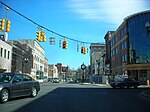St. Columba's School (Schenectady, New York)
1923 establishments in New York (state)Collegiate Gothic architecture in New York (state)National Register of Historic Places in Schenectady County, New YorkSchenectady County, New York Registered Historic Place stubsSchool buildings completed in 1923 ... and 2 more
School buildings on the National Register of Historic Places in New York (state)Schools in Schenectady County, New York
St. Columba's School is a historic school building located at Schenectady, Schenectady County, New York. It was built in 1923, and is a three-story, reddish-brown brick building in the Collegiate Gothic style. It features white Indiana limestone buttress amortizements, pinnacles, and a crenellated parapet. The school closed in 1974, and since 1976 the building has housed the local Boys and Girls Club.It was added to the National Register of Historic Places in 2015.
Excerpt from the Wikipedia article St. Columba's School (Schenectady, New York) (License: CC BY-SA 3.0, Authors).St. Columba's School (Schenectady, New York)
Stanley Street, City of Schenectady
Geographical coordinates (GPS) Address Nearby Places Show on map
Geographical coordinates (GPS)
| Latitude | Longitude |
|---|---|
| N 42.805277777778 ° | E -73.937777777778 ° |
Address
Stanley Street 701
12307 City of Schenectady
New York, United States
Open on Google Maps






